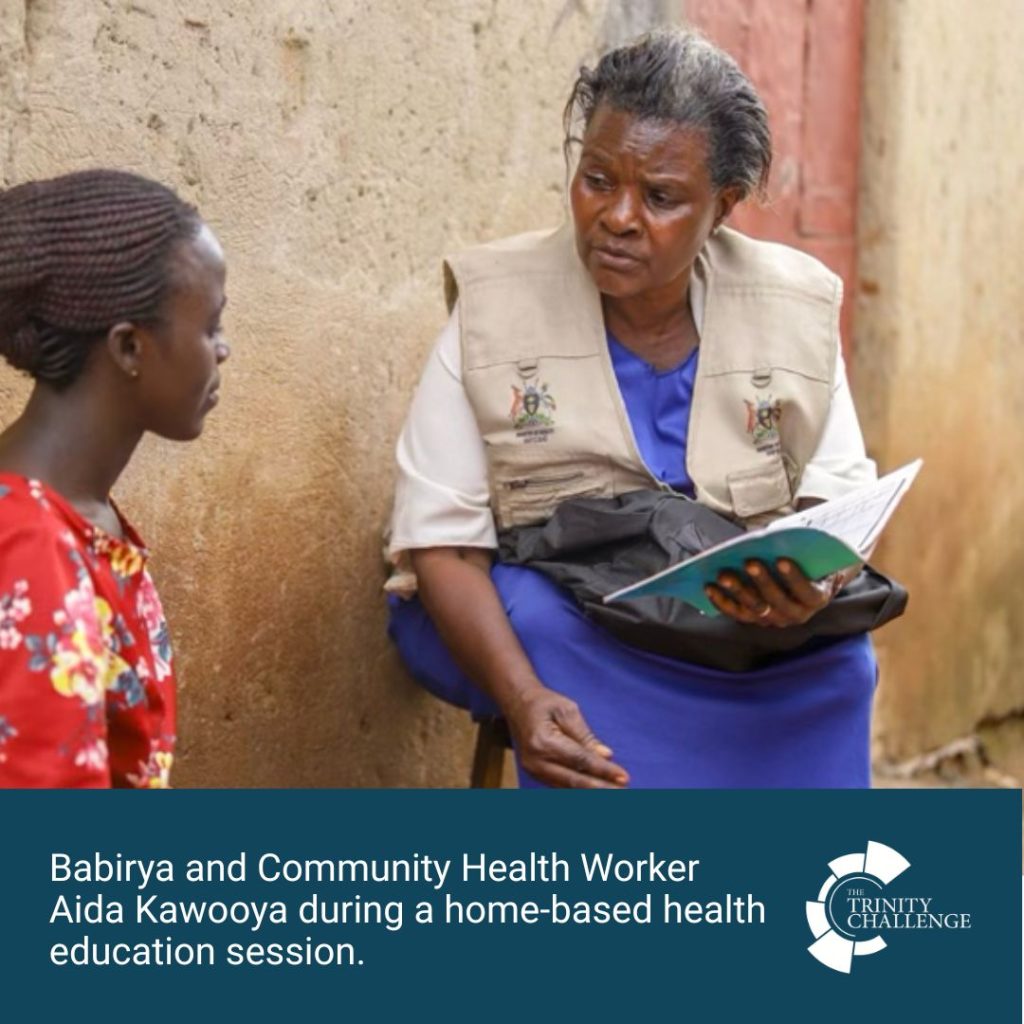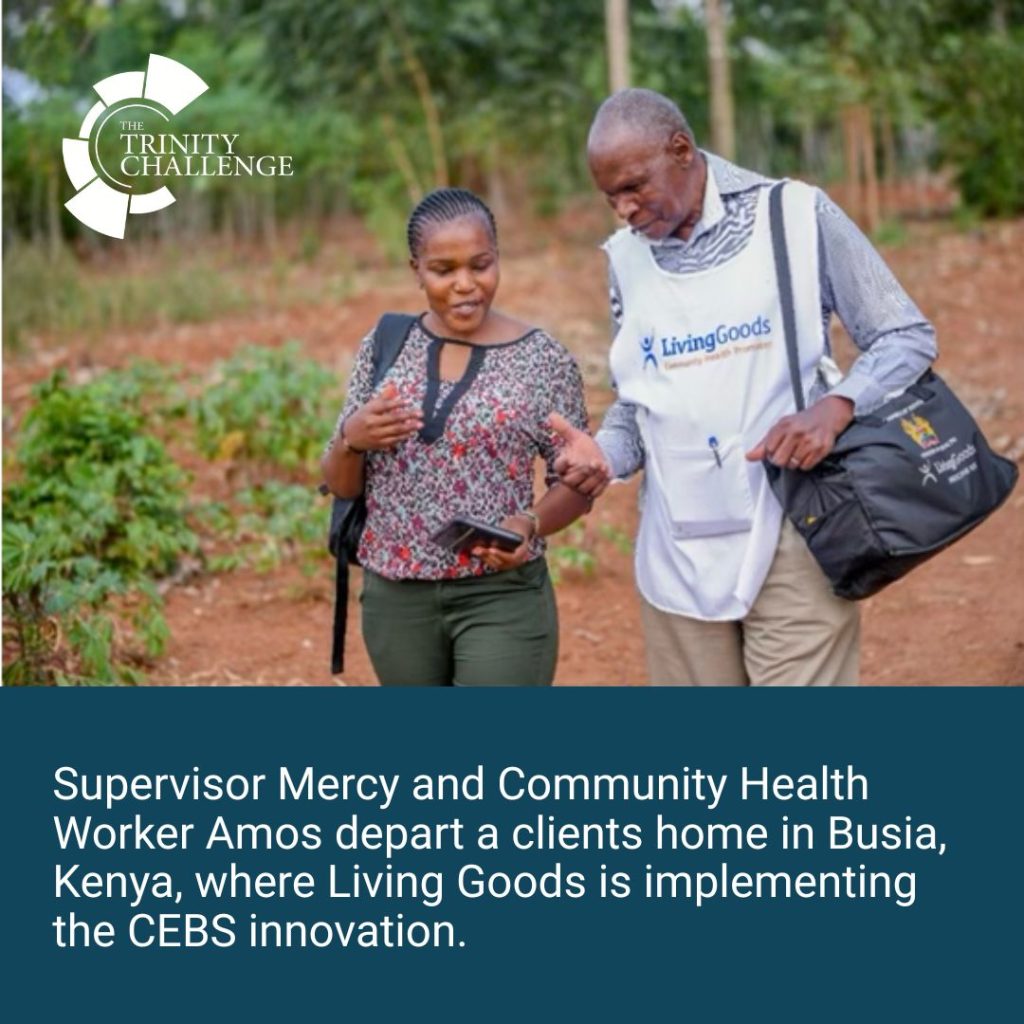28 August 2025
How Living Goods is Scaling Community Health Innovation Through Data and Partnership
Living Goods – a leading community health organisation operating in Kenya, Uganda and Burkina Faso – is advancing how governments deliver essential healthcare services by embedding innovation directly into national systems. With over 15 years of experience transforming how communities access care, Living Goods is now partnering with governments to integrate predictive analytics, e-learning for Community Health Workers (CHWs) and digital surveillance – building more resilient health systems that can weather any storm.
Through support from the Trinity Challenge’s (TTC) first challenge on pandemic preparedness, Living Goods launched two data-driven pilot projects: one focused on boosting immunisation coverage through predictive targeting, and the other on advancing community-based public health surveillance using a One Health lens. Both were implemented in close partnership with local and national governments and aligned with ongoing efforts to digitise and professionalise community health workforces.
Predictive Analytics for Immunisation Coverage
Challenge:
Reaching every child with lifesaving vaccines remains a persistent challenge, especially in hard-to-reach areas where access to care is limited and data systems are weak. Commonly referred to as “zero dose” children, those at high risk of missing their immunisation schedules are often not identified in time for intervention.
Innovation:
Living Goods developed a machine learning model trained on years of CHW-collected digital health data to predict which children are most likely to miss or delay vaccines. This enabled CHWs to proactively follow up with the right households, saving time and increasing impact.
What We Tested:
- A small-scale test was conducted in Mayuge, Uganda with 26 CHWs.
- The model flagged 112 at-risk children.
- CHWs conducted follow-up visits with 72 of those children.
- 36 of those children – 50% of those followed up – completed their full immunisation schedule within just 6 weeks.
- The original model had a false positive rate of 68.3% and a false negative rate of 10.7%.

What We Learned:
CHWs reported greater confidence and effectiveness using the prioritised lists. By replacing blanket screening with targeted outreach, they avoided unnecessary visits and spent more quality time with the families who needed it most.
“Seven years ago, parents used to hide their children from us because of fear and misinformation,” said Aida Kawooya, a Living Goods-supported CHW. “Now, 9 out of 10 children are vaccinated because our mobile app helps us follow up more easily and gives reminders in real time.”
Whilst the pilot did not track cost per child, a framework has been developed for the next phase. This will allow comparisons with standard outreach models using real-time app logs and dashboards to assess cost-efficiency and savings.
What’s Next
A new version of the model built using XGBoost, a state-of-the-art machine learning algorithm that excels in analysing large and complex datasets, has shown significantly stronger performance during internal validation. Key improvements include:
- 90.6% recall (sensitivity) in identifying at-risk children – meaning the model is highly effective at flagging children who are likely to miss or delay vaccinations
- 91.1% F1-score which balances correct identification with minimising false alerts, avoiding unnecessary follow-ups
- 96.7% predictive reliability, up from 78.7% in the original model – based on model calibration and consistency of prediction accuracy across subgroups
This upgraded version is currently undergoing real world testing. Simultaneously, Living Goods is working closely with government partners to embed predictive analytics into national digital platforms, like Kenya’s electronic Community Health Information System (eCHIS). Future phases aim to extend the model’s use to other vulnerable populations, with the goal of embedding machine learning into routine CHW workflows.
By leveraging machine learning within government systems, Living Goods is helping ensure that frontline workers reach children most at risk—faster and more efficiently. This supports the World Health Organisation’s goal to leave no one behind by enabling equitable, timely, and cost-effective immunisation coverage.
Community Event-Based Surveillance: A One Health Approach
Challenge:
Emerging health threats – ranging from zoonotic disease outbreaks to sanitation breakdowns – often go undetected at the community level until they escalate. Traditional surveillance systems rarely capture early warning signals in time, especially across sectors like animal and environmental health.
Innovation:
Living Goods developed a digital community event-based surveillance system (CEBS) using smartphone-based reporting tools and real-time dashboards. The system empowers CHWs to submit alerts on suspected health threats through a One Health lens, allowing for early response from multisectoral teams.
What Was Tested:
In Phase 1 (2023), 50 CHWs in Busia County, Kenya, were trained to report health threats using Survey CTO, a mobile-based digital data collection tool.
409 reports were submitted over three months, with a 92% reporting rate. These included unusual livestock deaths, zoonotic symptoms, dog bites, wildlife threats, sanitation issues, and human health concerns.
26 alerts were escalated as public health threats and validated by local authorities.

What We Learned:
The pilot demonstrates that CHWs are capable of accurately detecting and reporting early warning signs across multiple sectors. Local supervisors validated reports, which were then escalated through coordinated response teams.
Threats were addressed through multisectoral coordination, including veterinary officers, public health staff, and environmental health teams.
What’s Next:
Phase 2 of the CEBS pilot is now underway, integrating the platform into Kenya’s national eCHIS system and expanding the approach to 100 trained Community Health Promoters (CHPs).
- 65% of CHPs are actively submitting reports in the early months of Phase 2.
- Dashboards, SMS alerts, and WhatsApp-based coordination mechanisms are enabling faster and more organised responses.
- These tools reduce time spent manually reviewing data and allow response teams to prioritise verified signals by risk level, geography, and follow-up status.
By embedding CEBS into national digital systems, Living Goods is helping governments scale real-time, community-based surveillance that spans human, animal, and environmental health. This model strengthens pandemic preparedness and lays the foundation for more resilient health systems. As a result, frontline workers can be empowered with the tools and data they need to act early and save lives.
A New Model for National Scale
These innovations are not standalone pilots: they are embedded within a broader strategy to scale high-impact solutions through government-led platforms.
“We’re at a critical moment for resilience and preparedness,” a senior Living Goods representative said. “We already have national digital systems in place. The opportunity now is to layer innovation – predictive analytics, one health surveillance, digital referrals – on top of these systems to ensure they are as impactful and efficient as possible.”
Government partners are increasingly investing in both the staff and digital infrastructure needed to take these solutions forward. Ministries of Health are deploying community health workers, equipping them with digital tools, and integrating early warning and targeting systems into their official workflows.
Thanks to catalytic support from The Trinity Challenge, Living Goods has been able to test, refine, and begin institutionalising these models. Kenya now serves as a critical learning hub, while Uganda and Burkina Faso represent exciting frontiers for adapting and expanding these approaches.
Together with national governments and global partners such as Jhpiego, Living Goods is helping shape a new model for digital health at scale, where predictive tools and community-level surveillance ensure faster, smarter, and more equitable care for all.
Lifesaving health services
- Today, Living Goods supports 8,370 community health workers (CHWs) to deliver exceptional frontline healthcare to 4 million people across Burkina Faso, Kenya, and Uganda. CHWs provide a comprehensive set of health services, from checking that each child is immunised to ensuring all pregnant women receive pre- and postnatal care.
- Since 2022, Living Goods has supported the development of policies affecting 275,000 CHWs and over 68.5 million people.
- Today, there are more than 132,000 CHWs active on digital tools co-designed by Living Goods.
